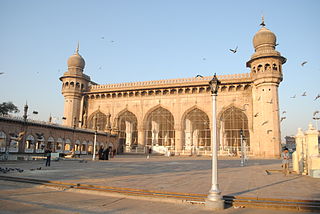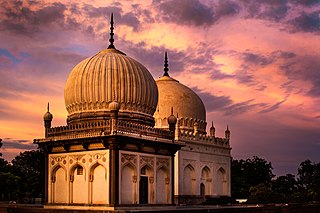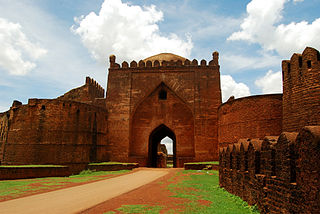
The Deccan sultanates were five late-medieval Indian kingdoms—on the Deccan Plateau between the Krishna River and the Vindhya Range—that were ruled by Muslim dynasties: namely Ahmadnagar, Berar, Bidar, Bijapur, and Golconda. The sultanates had become independent during the break-up of the Bahmani Sultanate. The five sultanates owed their existence to the declaration of independence of Ahmadnagar in 1490, followed by Bijapur and Berar in the same year. Golconda became independent in 1518, and Bidar in 1528.

The Qutb Shahi dynasty was a Persianate Shia Islamic dynasty of Turkoman origin that ruled the Sultanate of Golkonda in southern India. After the collapse of Bahmani Sultanate, the Qutb Shahi dynasty was established in 1512 AD by Sultan-Quli Qutb-ul-Mulk, better known though less correctly referred to in English as "Quli Qutb Shah".

Ibrahim Qutb Shah Wali, also known by his Telugu names Malki BhaRama and Ibharama Cakravarti, was the fourth monarch of the kingdom of Golconda in southern India. He was the first of the Qutb Shahi dynasty to use the title "Sultan". He ruled from 1550 to 1580. He lived for seven years in exile at the court of Vijayanagara as an honoured guest of Rama Raya. Ibrahim is known for patronizing Telugu extensively because he was moved by a genuine love for the language.

Abdullah Qutb Shah was the seventh ruler of the kingdom of Golconda in southern India under the Qutb Shahi dynasty. He ruled from 1626 to 1672.

Abul Hasan Qutb Shah, also known as Abul Hasan Tana Shah was the eighth and last ruler of the Qutb Shahi dynasty, sovereign of the Kingdom of Golconda in South India. He ruled from 1672 to 1686. The last Sultan of this Sunni Islamic dynasty, Tana Shah is remembered as an inclusive ruler. Instead of appointing only Muslims as ministers, he appointed Brahmin Hindus such as Madanna and Akkanna brothers as ministers in charge of tax collection and exchequer. Towards the end of his reign, one of his Muslim generals defected to the Mughal Empire, who then complained to Aurangzeb about the rising power of the Hindus as ministers in his Golconda Sultanate. Aurangzeb sent a regiment led by his son, who beheaded Tana Shah's Hindu ministers and plundered the Sultanate. In 1687, Aurangzeb ordered an arrest of Tana Shah, who was then imprisoned at the Daulatabad Fort. He died in prison in 1699.

Golconda is a fortified citadel and ruined city located in the western outskirts of Hyderabad, Telangana, India. The fort was originally built by Kakatiya ruler Pratāparudra in the 11th century out of mud walls. It was ceded to the Bahmani Kings by Deo Rai, Rajah of Warangal during the reign of Sultan Muhammad Shah of the Bahmani Sultanate. Following the death of Sultan Mahmood Shah, the Sultanate disintegrated and Sultan Quli, who had been appointed as the Governor of Hyderabad by the Bahmani Kings, fortified city and made it the capital of the Golconda Sultanate. Because of the vicinity of diamond mines, especially Kollur Mine, Golconda flourished as a trade centre of large diamonds known as Golconda Diamonds. Golconda fort is currently abandoned and in ruins. The complex was put by UNESCO on its "tentative list" to become a World Heritage Site in 2014, with others in the region, under the name Monuments and Forts of the Deccan Sultanate.

Makkah Masjid or Mecca Masjid, is a congregational mosque in Hyderabad, India. It is the largest mosque in the city, and one of the largest mosques in the country, with a capacity of 10,000 people. The mosque was built during the 17th century, and is a state-protected monument. It serves as the primary mosque for the Old City of Hyderabad, and is located close to the historic landmarks of Charminar, Chowmahalla Palace and Laad Bazaar.

Indo-Islamic architecture is the architecture of the Indian subcontinent produced by and for Islamic patrons and purposes. Despite an initial Arab presence in Sindh, the development of Indo-Islamic architecture began in earnest with the establishment of Delhi as the capital of the Ghurid dynasty in 1193. Succeeding the Ghurids was the Delhi Sultanate, a series of Central Asian dynasties that consolidated much of North India, and later the Mughal Empire by the 15th century. Both of these dynasties introduced Islamic architecture and art styles from West Asia into the Indian subcontinent.

Delhi has been an important political centre of India as the capital of several empires. The recorded history of Delhi begins with the 8th century Tomar Rajputs kingdom. It is considered to be a city built, destroyed and rebuilt several times, as outsiders who successfully invaded the Indian subcontinent would ransack the existing capital city in Delhi, and those who came to conquer and stay would be so impressed by the city's strategic location as to make it their capital and rebuild it in their own way.

Taramati Baradari is a historical sarai as part of Ibrahim Bagh, a Persian style garden built during the reign of Ibrahim Quli Qutub Shah, the fourth Sultan of Golconda.

The Qutub Shahi Tombs are located in the Ibrahim Bagh, close to the famous Golconda Fort in Hyderabad, India. They contain the tombs and mosques built by the various kings of the Qutub Shahi dynasty. The galleries of the smaller tombs are of a single storey while the larger ones are two storied. In the centre of each tomb is a sarcophagus which overlies the actual burial vault in a crypt below. The domes were originally overlaid with blue and green tiles, of which only a few pieces now remain.
Hussain Shah Wali was a sufi saint of Golkonda, during the reign of Qutb Shahi dynasty. He is credited with building the Hussain Sagar at Hyderabad in the year 1562. The mausoleum and shrine at the Qutb Shahi Tombs called Dargah Hussain Shah Wali was built by Abdullah Qutb Shah in his honour. He is a Hussaini sayyid and descendant of Khwaja Banda Nawaz. He died in 1620.
Toli chowki is a neighbourhood in Hyderabad, Telangana, India. The name Tolichowki comes from the Urdu word 'Toli', meaning 'troupe', and 'Chowki', meaning 'post'. It is close to the IT corridor like Gachibowli, Madhapur, Manikonda and Kondapur, hence making it a preferred residential for people working in the IT industry. The real estate sector has received a boost due to its proximity to high-end technology firms. Tolichowki has also had a boost in the restaurant and fast food industry. It is known to attract many customers from all around due to having multi-cuisine meals all around the area. There has been an emergence of Arab cuisine in the area due to Middle Eastern people's moving in the area for medical or academic purposes. This in return has improved Tolichowki's market value for foreigners

The siege of Golconda was a siege of Golconda Fort between the Qutb Shahi dynasty and the Mughal Emperor Aurangzeb, occurring in January 1687, lasting 8 months. The fort was home of the Kollur Mine. The Golconda Fort was considered to be an impregnable fort on the Indian subcontinent. At the end of the siege, Aurangzeb and the Mughals entered Golconda victorious.

Mirza Muhammad Sultan was the eldest son of Mughal emperor Aurangzeb and his second wife Nawab Bai. His younger brother Muazzam later became Emperor as Bahadur Shah I in 1707.
Hyderabad was the capital of the Indian states of Telangana and Andhra Pradesh. It is a historic city noted for its many monuments, temples, mosques and bazaars. A multitude of influences has shaped the character of the city in the last 400 years.

Persian Inscriptions on Indian Monuments is a book written in Persian by Dr Ali Asghar Hekmat E Shirazi and published in 1956 and 1958 and 2013. New edition contains the Persian texts of more than 200 epigraphical inscriptions found on historical monuments in India, many of which are currently listed as national heritage sites or registered as UNESCO world heritage, published in Persian; an English edition is also being printed.

The history of Telangana, located on the high Deccan Plateau, includes its being ruled by the Satavahana Dynasty, the Kakatiya Dynasty (1083–1323), the Musunuri Nayaks (1326–1356), the Delhi Sultanate, the Bahmani Sultanate (1347–1512), Golconda Sultanate (1512–1687) and Asaf Jahi dynasty (1724-1950).

Deccani Architecture refers to the architectural styles developed during the Deccan sultanate period. The Deccan sultanates were five dynasties that ruled late medieval kingdoms, namely, Bijapur, Golkonda, Ahmadnagar, Bidar, and Berar in south-western India. The Deccan sultanates were located on the Deccan Plateau. Their architecture was a regional variant of Indo-Islamic architecture, heavily influenced by the styles of the Delhi Sultanate and later Mughal architecture, but sometimes also directly from Persia and Central Asia.
Hayat Bakshi Begum was the royal consort of Sultan Muhammad Qutb Shah, the sixth ruler of the Qutb Shai Dynasty in south India and daughter of Muhammad Quli Qutb Shah, fifth Sultan of the dynasty. When her son Abdullah Qutb Shah was made sultan at the age of fourteen in 1626, she acted as regent for the first few years of his reign, and continued to wield considerable influence in the state until her death.




















